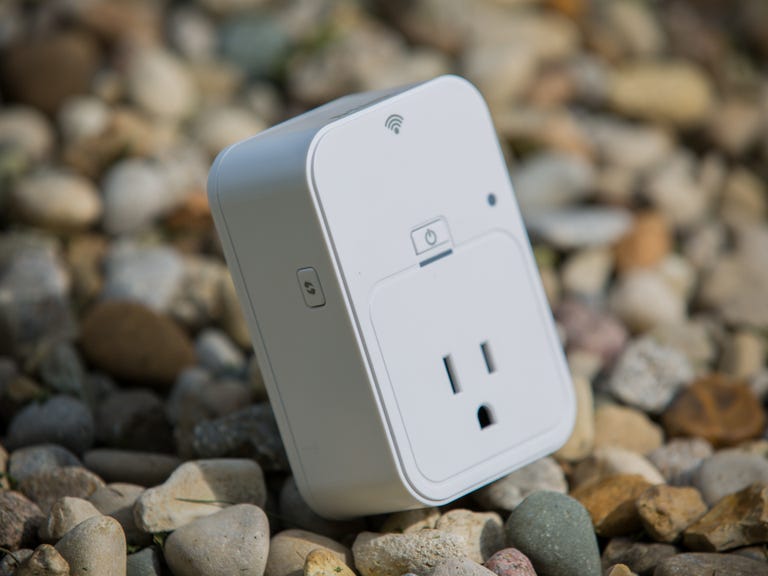 Why You Can Trust CNET
Why You Can Trust CNET D-Link Wi-Fi Smart Plug review: This so-called smart plug should be held back
Can D-Link's $50 Wi-Fi Smart Plug impress without IFTTT compatibility?
The $50 D-Link Wi-Fi Smart Plug is a decent option if you're interested in basic home automation. Pair the plug with a lamp or other small appliance and use D-Link's free Android or iOS app to turn it on and off, set custom schedules, and monitor its energy usage. It's very similar to the $60 Belkin WeMo Insight Switch and the $50 Belkin WeMo Switch , except for one key difference: D-Link's version isn't compatible with IFTTT.
The Good
The Bad
The Bottom Line
On the performance side, D-Link's Wi-Fi Smart Plug and app were both periodically glitchy during testing. While D-Link's Wi-Fi Smart Plug is OK at performing its functions, it doesn't seem like it can compete with the thoughtful dependability of Belkin's WeMo switches. I'd stick with Belkin even if IFTTT compatibility isn't on the top of your connected-home wish list.
This white, single-outlet plug measures 3.5 inches tall by 2.4 inches wide by 1.4 inches deep. It weighs 4.4 ounces and has a rectangular shape with rounded-off edges. It's rated for 100 to 125 volts of alternating current (VAC). That means that the outlet should be used to power lamps or other small appliances (large appliances have higher VAC requirements).
The Mydlink Smart Plug app works with Android 4.0 or higher and iOS 6 or higher on tablets and smartphones, and on Wi-Fi and cellular connections. It operates on a 2.4GHz Wi-Fi frequency and you can control up to 10 different Wi-Fi Smart Plugs at the same time using the app.
But just when I was about to blame the blandness of traditional outlets for the blandness of this smart outlet, I started thinking about Dyson's vacuum cleaners and Nest's thermostats . Both companies have managed to make household objects into design statements rather than something you try to hide in a dark corner. They weren't satisfied with the uninspired design that dominates their appliance categories, so why should D-Link's plug look so plain?
D-Link isn't alone, though. Its Wi-Fi Smart Plug is similar in style to the $50 Belkin WeMo Switch , the $60 Belkin WeMo Insight Switch , and the $49 SAM plug . Still, Belkin definitely improved on its plug design between the WeMo Switch and its more recently introduced Insight Switch, so I'm not quite ready to let D-Link off the hook.
I had a really hard time actually finding the Mydlink Smart Plug app in both the iOS and Android app stores. In the Google Play store it's called Mydlink WiFi Smart Plug and in iTunes it's called Smart Plug.
Once I found and downloaded both apps, setup got easier, but there were still a couple of confusing parts. For example, the setup menu gives you the option of a WPS setup or a manual setup. If you have a router with WPS, then this is fairly straightforward. If you don't, you have to go the manual setup route. That's the option I chose and you have to use a six-digit pin code located on a small card that's included in the box (it's also on the back of your plug, but that's plugged in at this point, so that's no help). After I entered the code, I selected the office Wi-Fi network and it connected.
After setup, I plugged a nearby lamp into the Wi-Fi Smart Plug and was able to control it via the app. I created schedules, checked the lamp's wattage, and monitored its temperature readings from both Wi-Fi and cellular connections on my iPhone 5 and a Motorola Droid Maxx .
Things were going well, but then I ran into a curious problem while using the iOS app. You're supposed to be able to receive reminders based on the schedules you set. However, the enable button for this function was grayed out and I couldn't slide it over to "on." I didn't have the same problem in the Android app.
The biggest issue I encountered, though, happened when I unplugged the Smart Plug. Even if it had only been disconnected for a few minutes, it didn't always remember the product I had just successfully set up. This happened often enough that I kept the small card with my six-digit code handy, knowing that I would have to start the setup process all over again.
Now, a lot of you will probably pick the product you want to control and leave it plugged in. Just be aware that if you did decide to remove it temporarily (no matter how briefly), the app might not reflect all those steps you completed earlier. I have three different Belkin WeMo products set up in my WeMo app and at various times certain ones are plugged in and connected and others aren't. Still, every time I reconnect them, they always dutifully reappear in the list of products as if they had been there all along.
While I was initially intrigued by a device that costs the same as Belkin's standard WeMo Switch, but offers energy usage information similar to Belkin's more expensive $60 WeMo Insight Switch, D-Link's Wi-Fi Smart Plug disappointed at almost every turn. Simply put, it has too many inconsistencies to recommend. Consider one of the Belkin smart switches if you want something that actually remembers the products you set up and has the added bonus of IFTTT compatibility.


